14,000 PASSENGERS PER SEASON BY CHARS-A-BANCS.
Page 8
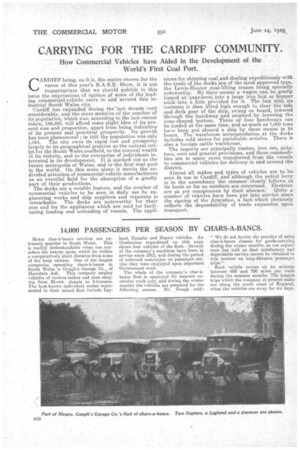
Page 9
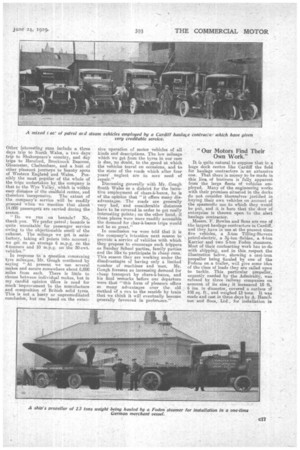
Page 10
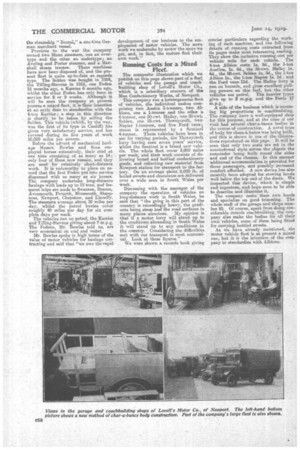
Page 12
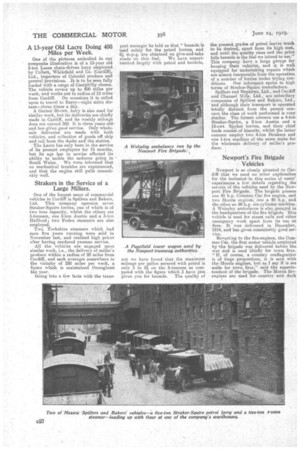
Page 13
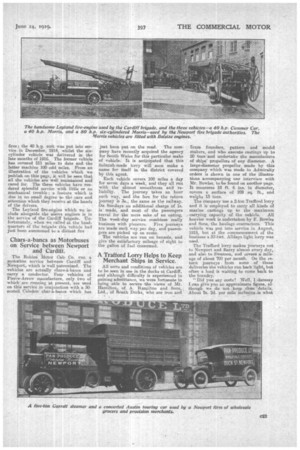
Page 14
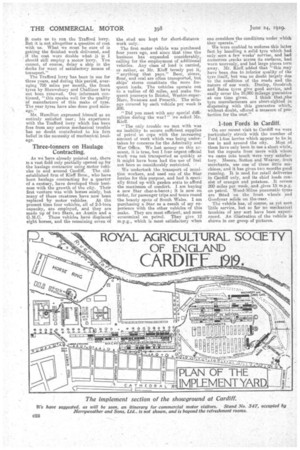
If you've noticed an error in this article please click here to report it so we can fix it.
Motor char-a-bancs services are extremely-popular in South Wales. This is readily understandable when one considers the beauty spots which lie within a comparatively short distance from some of the busy centres. One of the largest companies operating chars-a-bancs in South Wales is Gough's Garage Co., of Mountain Ash. This company employ vehicles of various makes and sizes ranging from 30-cwt. chassis to 4-tonners. Thebest-known individual makes represented in their mixed fleet include Ley
land, Daimler and Napier vehicles. An illustration reproduced on this page shows four vehicles of the fleet. Several of the company's machines have been in service since 1913, and during the period of enforced restriction on passenger service they were employed upon important Government work.
The whole of, the company's char-abanes fleet is employed for summer excursion work only, and during the winter months the-vehicles are prepared for the following season. Mr. Gough said: " We do not favour the practice of using char-a-bancs chassis for goods-carrying during the winter months, as our experi. ence has told us that satisfactory and dependable service cannot be obtained in this manner on long-distance passenger trips."
Each vehicle covers on an average between 600 and 700 miles per week during the summer months. The longest trips which the company at present make are along the south coast of England, when the vehicle § are away for six days.
Other interesting runs include a three days trip to North Wales, a two day trip to Shakespeare's country, and day trips to Hereford, Brecknock Beacons, Gloucester, Cheltenham, and a host of other pleasant journeys to beauty spots of Western England and Wales. Possibly the most popular of the whole of the trips undertaken by the company is that to the Wye Valley, which is within easy distatnce of the coalfield centre, and therefore \inexpensive. The extent of the company's service will be readily grasped when we mention that about 14,000 passengersare carried during the seaSon.
"Do we run on 'benzoic? No, thank you. We prefer petrol; benzole is quite unsuitable for passenger service owing to the objectionable smell of the exhaust, The mileage we get is satisfactory, taking all points into account ; we get on an average 6 m.p.g. on the 4-tormers and 10 m.p.g. on the 30-cwt. vehicles."
In response to a question concerning tyre mileages, Mr. Gough continued by saying "At present we use several makes and secure somewhere about 6,000 miles from each. There is little to choose between individual makes, but in my candid opinion Were is need for muchimprovement In the manufacture and composition of British solid tyres. This is not a hasty or unpremeditated conclusion, but one based on the exten
sive operation of motor vehicles of all kinds and descriptions. The low mileage which we get from the tyres in our case is due no doubt, to the peed at which the vehicles travel on occasions, and to the state of the roads which after four years' neglect are in sore need of repair," Discussing generally with Mr. Gough South Wales as a district for the lucrative employment of chars-i-bancs, he is of the opinion that "it offers many disadvantages. The roads are generally very bad, and considerable distances have to he covered in order to get really interesting points; on the other hand, if these places were more readily accessible the demand for char-iobancs trips would not be so great."
In conclusion we were told that it is the company's intention next season to provide a service of vehiCles with which they propose to encourage such trippers as Sunday School parties, family parties and the like to participate in cheap runs. This season they are working under the disadvantages of having only a limited number of machines and men. Mr. Gough foresees an increasing demand for cheap transport by chars-&-banes, and his final remarks before our departure were that "'this form of pleasure offers so many advantages over the old method of a run to the seaside by train that we think it will eventually become generally favoured in preference." "Our Motors Find Their Own Work."
It is quite natural to suppose that in a huge dock centre like Cardiff the field for haulage contractors is an extensive one. That there is money to• be made in this line, of business is fully apparent from the large fleets of vehicles employed. Many of the engineering works with their premises situated in the docks do not consider themselves justified in buying their own vehicles on account of the spasmodic use to which they would be put, and it is here that the door of enterprise is thrown open to the alert haulage contractor.
Messrs. F. Bowles and Sons are one of the largest haulage contractors in Cardiff, and they have in use at the present time five vehicles, a 3-ton Tilling-Stevens petrol-electric, a 3i-ton Selden, a 4-ton Karrier and two 5-ton Poden steamers. Most of their contracting work has tce do with shipping, and in this respect the illustration below, showing a cast-iron propeller being &hauled by one of the Fodens on a trailer, will give some idea of the class of loads they are called upon to tackle. This particular propeller, urgently needed by the Admiralty, was refused by three railway companies on account of its size.; it measured 18 ft. 6 ins, in diameter, covered a surface of 108 sq. ft., and weighed 13 tons. It was madeand cast in three days by A. Hamilton and Sons, Ltd., for installation in the steamship " Booral," a one-time German merchant vessel.
Previous to the war the company owned two Mann steamers, one an overtype and the other an undertype; an Aveling and Porter steamer, and a Mar
shall steam tractor. These machines have now been disposed of, and the present fleet is quite up-to-date as regards type. The Selden was bought in 1914, the Tilling-Stevens in 1915, one Foderr 12 months ago, a Karrier 6 months ago, whilst the other Foden has only been in service for 8 Or 9 weeks. Although it will be seen the company at preeent possess a mixed fleet, it is their intention at an early date to standardize with the 4-ton Karrier; a step in this direction is shortly to. he taken, by selling the Selden. This vehicle (which, by the way, was the first of its type in Cardiff) has given very satisfactory service, and has covered during its five years of work 10,000 miles per annum.
Before the advent of mechanical haulage Messrs. Bowles and Sons employed horses extensively, their stud at one time consisting of as many as 14; only four of these now remain, and they are, used for relatively short-distance work. It is noteworthy to place on record that the first Foclen put into service dispensed with as many as six horses. The company underbale long-distance haulage with loads up to 15 tons, and frequent trips are made to Swansea, Brecon, Avonmouth, Periarth, Monmouth, Sharpness, Newport, Chepstow, and Llanelly. The steamers average about 30 miles per day, whilst the petrol lorries cover Toughly 40 miles per day for six complete days per week. The vehicles run on petrol, the Karrier and Tilling-Stevens giving about 7 m.p.g. The Fodens, Mr. Bowles told us, are very economical on coal and water.
Mr. Bowles spoke in high terms of the value of motor vehicles for haulage contracting and said that "we owe the rapid
development of our business to the employment of motor vehicles. The more work we undertake 'by motor the more we get, and, in fact, the motors find their own work."
Running Costs for a Mixed Fleet.
The composite illustration which we publish on this page shows part of a fleet of vehicles and the garage and coach 'building shop of Lovell's Motor Co., which is a, subsidiary concern of the Mon Confectionery Works, of Newport.
This company run a heterogeneous fleet of vehicles, theindividual makes comprising two Austin 3-tanners, wo AIbions, one a, 1-tonner and the other a 4-tenner, one 50-cwt. Halley, one 50-cwt. Seidel', one 25-cwt. Thornycroft, My° Napier 1-tonners, and five Ford vans; steam is represented by a Sentinel 4-tonner. These vehicles have been in use for varying periods, the Thornycroft lorry having seen seven years' service, whilst the Sentinel is a brand new vehicle. The whole fleet cover 3,000 miles per week, and their work consists of delivering boxed and bottled confectionery goods, and collecting raw material from Newport station for transport to the factory. On an average about 8,000 lb. of boiled sweets and chocolates are delivered over a wide area in South Wales per week.
Discussing with the manager of the company the operation of vehicles on long-distance work in South Wales, he said that "the going in this part of the country is exceedingly heavy, the gradients being steep 'and the road surfaces in many places atrocious. My opinion is that if a motor lorry will stand up to the conditions abounding in South Wales it will stand up to any conditions in the country. Considering the difficulties met with our transport is most economical. Look at these figures."
We were shown a records book giving
concise particulars regarding the working of each machine, and the following details of running costs extracted from its pages make most interesting reading. They show the inclusive running cost per vehicle mile for each vehicle. The 4-ton Albion costs Is. &I., the 3-ton Austins, Is. 4d.' the 50-cwt. Halley is. 4d., the 50-cwt. Seidel) Is. 3d., the 1-ton .Albion is., the 1-ton Napier 1.s. Id., and the Ford vans 11d. The Halley lorry is run on benzole, and gives excellent pulling powers on this fuel, but the other vehicles use petrel. The heavier types give up to 8 m.p.g. and the Fords 17 m.p.g,.
A side of the business which is assuming big proportions is coachbuilding. The company have a well-equipped shop for this purpose, and at the time of our visit had several char-a-bancs bodies in the course of construction. A novel type of body for chars-a-bancs was being built, and this is shown in one of the illustrations reproduced on this page. It will be seen that only two seats are set in the conventional style across the chassis the remainder being built round the sides and end of the chassis. In this manner additional accommodation is provided for three passengers, and possibly increased comfort afforded. A new device has also recently been adopted for stowing hoods well below the top rail of the doors. We inspected this device, which is simple and ingenious and hope soon to be able to describe and illustrate it.
The company make their own hoods and specialize on good trimming. The whole staff of the garage and shops nonher 50. Of course, apart from doing considerable outside coachbuilding, the company atm make the bodies for all their own vehicles, some of them being fitted for carrying bottled sweets,
As we have already mentioned, the motor vehicle fleet is at present a mixed one, but it is the intention of the company to standardize with Albions.
A I3-year Old Lacre Doing 400 Miles per Week.
One of the pictures embodied in our composite illustration is of a 13-year old 3-ton Lacre chain-driven lorry employed. by Collett, Whitefield and Co. (Cardiff), Ltd., importers of Colonial produce and general provisions.. It is to be seen fully loaded With a cargo of Caerphilly cheese. The vehicle covers up to 400 miles per week, and works out to radius of 12 miles
from Cardiff. On occasions it isr called upon to travel to Barry—eight miles distant—three times a day. A Garner 30-cwt. lorry is also used for similar work, but its deliveries are chiefly made in Cardiff, and its weekly mileage does not exceed 300. It is three years old. and has given good service. Only wholesale deliveries are made with both vehicles, and collection of goods off ship and rail from the docks and the station.
• The Lacre has only been in the service of its present employersfor 18 months, but its age has in nowise affected its ability to tackle the arduous going in South Wales. We were informed that no mechanical troubles are experienced, and that the engine still pulls remarkably well.
Shakers in the Service of .a Large Millers.
One of the largest users of commercial vehicles in Cardiff is Spillers and Bakers, Ltd. This company operates seven Straker-Squire lorries, one of which is of two tons capacity, whilst the others are 5-tonners, one 3-ton Austin and a 3-ton Eallford ; two Foden steamers are also employed.
Two Yorkshire steamers which had seen five years running were sold in November last, and realized high prices after having rendered yeoman service. All the vehicles are engaged upon similar work, i.e., the delivery of miller's produce within a radius of 2411 miles from Cardiff, and each averages somewhere in the vicinity of 250 miles per week, a figure which is maintained throughout the year.
Going into a few facts with the trans port manager he told us that " benzoic)• is used solely for the petrol lorries, and 83/4 m.p.g. are obtained on give-and-take roads on this fuel. We have experimented largely with petrol and benwle,
out we have found that the maximum mileage per gallon secured with petrol is only 5 to 5on the 5-tonners as compared with the figure which have just given you for benzole. The quality of the present grades of petrol leaves much to be desired, apart from its high cost, and until the quality rises and the price falls benzole is the fuel we intend to use." This company have a large garage for housing their vehicles, and it is well equipped for undertaking repairs which are almost inseparable from the operation of a number of lorries under trying conditions. Our informant spoke in high terms of Straker-Squire manufacture. Spillers and Nephews, Ltd., and Cardiff and Channel Mills, Ltd., are subsidiary companies of Spillers and Bakers, Ltd., and although their transport is operated totally distinct from the parent concern the class of work performed is very similar. The former concern use a 4-ton Straker-Squire, a 2-ton Austin and a 15-cwt Spyker lorries, and their chief loads consist of biscuits, whilst the latter concern employ two 4-ton Strakers and one 1-ton machine of the same make for the wholesale delivery of miller's produce.
Newport's Fire Brigade Vehicles
Newport is so closely situated to Cardiff that we need no other explanation for the inclusion in this series of users' experiences a few details regarding the service of the vehicles used by the Newport Fire Brigade. The brigade possess one 40 h.p. Commer. Car fire engine, and two Morris engines, one a 40 h.p. ah the other an 80 h.p. six-cylinder machine. A Wolseley ambulance is also garaged in the headquarters of the fire brigade. This vehicle is used for street calls and other emergency work apart from its use at fires. It was delivered in December, 1914, and has given remarkably good service.
IteverVng to the fire-engines, the Commer Car, the first motor vehicle employed by -the brigade was delivered before the war and is used Chiefly for town fires. "If, of course, a country conflagration is of huge proportions, it is sent with the Morris engines, but as I say it is set aside for town fires," said the superin-tendent of the brigade. The Morris fireengines are used for country and dock
fires; the 40 h.p. unit was put into service in December, 1914, whilst the Eacylinder vehicle was delivered in the late months of 1916. The former vehicle has covered 511 nnles to date and the latter machine 100 odd miles. From an illustration of the vehicles which we publish on this page, it will be seen that all the vehicles are weal maintained and eared for. The three vehicles have rendered splendid service with little or no mechanical trouble ; a feature which is due in no small degree to the care and attention which they receive at the hands of the drivers.
The Leyland fire-engine which we include alongside the above engines is in the service of the Cardiff brigade. Unfortunately, when we called at the headquarters of the brigade this vehicle had just been summoned to a distant fire
Chars-a-bancs as Motorbuses on Service between Newport and Cardiff.
The Robins Motor Cab Co. run a motorbus service between Cardiff and Newport,. which is well patronized. The vehicles are actually chars-a-bancs and carry a conductor. Four vehicles of Pierce-Arrow manufacture, only two of -which are running at present, are used on this service in conjunction with a 30seated Caledon char-a-banes which has just been put on the road. The company have recently acquired the agency for South Wales for this particular make of vehicle. It is anticipated that this ScOttish-made lorry will soon make a name for itself in the district covered by this agent.
Each vehicle covers 100 miles a day for seven days a week, and they all run with the utmost smoothness and reliabilty. The journey takes an hour each way, and the fare for the return journey is 3s., the same as the railway. On Sundays an additional charge of is. is made, and most of the passengers travel for the mere sake of an outing. The week-day service combines really business with pleasure. Five journeys are made each way per day, and passengers are picked up en route.
The vehicles are run on benzole, and give the satisfactory mileage of eight to the gallon of fuel consumed.
A Trafford Lorry Helps to Keep Merchant Ships in Service.
All sorts and conditions of vehicles are to be seen in use in the docks at Cardiff, and although difficulty is experienced in gaining admittance, we were fortunate in ping able to secure the views' of Mr. Hamilton, of A. Hamilton and Sons, Ltd., 'of. Roa.th. Docks, who are iron and brass founders, pattern and model makers, and who execute castings up to,
20 tons 'and undertake the manufacture of ships' propellers of any diameter. A large-diameter propeller made by this company which was made to Admiralty orders is shown in one of the illustrations accompanying oor interview with Mr. Bowles, to 'be found on another page. It measures 18 ft. 6 ins, in diameter, covers a surface of 108 sq. ft., and weighs 13 tons.
. The companyuse a 2-ton Trafford lorry and it is employed to carry all kinds of
marine castings up to the maximum carrying capacity of the vehicle. All heavier work is undertaken by F. Bowles and Sons, the haulage contractors. This vehicle was put into service in August, 1915, but at the commencement of the business a 30-cwt. /Mays light lorry was used.
The Trafford lorry makes journeys out to Newport and Barry almost every day, and also to Swansea, and covers a mile age of about 700 per month. On the return journeys from some of these deliveries the vehicles run back light, but often a load is waiting to come back to the foundry. "Did you. say costs? Weil, I daresay I can give you an approximate figure, although we do not keep cloee About is. 2d. per mile inclusive,is what
it costs us to rim the Trafford lorry. But it is not altogether a question of cost with us. What we must be sure of is get4ing the finished work delivered, and if the cost were double what it is I should still employ a motor lorry. You cannot, of course, delay a ship in the docks for want of satisfactory means of transport.''
The Trafford lorry has been in use for three years, and during this period, averaging 700 miles per month, the front tyres by Shrewsbury and Challiner have not been renewed. Our informant con tinned, "this speaks well for the quality of manufacture of this make of tyre. The rear tyres have also done good mileage." Ms. Hamilton expressed himself as an entirely satisfied user ; his experience with the Trafford lorry which has been free from any serious mechanical trouble has no doubt contributed to his firm belief in the necessity of mechanical haulage.
Three-tonners on Haulage Contracting.
As we have already pointed out, there is a vast field only partially opened up for the haulage contractor using motor vehi
cles in and around Cardiff. The oldestablished firm of Kieff Bros., who have been haulage contracting for a quarter of a century, have developed their business -with the growth of the city. Their first venture was with horses solely, bat many of these creatures have now been replaced 'by meter vehicles. At the present time four vehicles, all of 2-3-tons capacity, are employed, and they are made up of two Stars, an Austin and a G.M.C. These vehicles have displaced eight horses, mid the remaining seven of
the stud are kept for short-distance work only.
The first motor vehicle was purchased four years ago, and since that time the business has • expanded considerably, calling for the employment of additional vehicles. Any class of load is carried, or rather, as Mr. Kieff tersely put it, " anything that pays." Beer, stores, flour, and coal are often transported, but, ships' stores constitute the more frequent loads. The vehicles operate out to a radius of 60 miles and make frequent journeys to Bristo!, Weston-superMare, Swansea and Penarth. The mileage covered by each vehicle per week is 360.
"Did you meet with any special difficulties during the war?" we asked Mr. 'Goff.
"The only trouble we met with was an inability to secure sufficient supplies of petrol to cope with the increasing amount of work which was being undertaken by concerns for the Admiralty and War Office. We lost money on this account, it is true, rind I fear urgent official work was not transported as quickly as it might have been had the use of fuel not been so considerably restricted.
We undertook the transport of munition workers, and used one of the Star lorries for this purpose, and had it specially fitted up with garden seats to afford the maximum of comfort. I am buying a new Star char-a-banes ; it is now on order, for passenger trips and tours round the beauty spots of South Wales. I am purchasing a Star as a result of my experience with the other vehicles of this make. They are most efficient, and most economical on petrol. They give 12 m.p.g., which is most satisfactory when one considers the conditions under which they operate."
We were enabled to endorse this latter fact by handling a solid tyre which had only seen a few weeks' servioe, and had numerous cracks across its surfaces, had worn unevenly, and had large pieces torn away. Mr. Kieft; added that this may have been this to inferior quality of the tyre itself, but was no doubt largely due to the condition of the roads and the nature of our work. Dunlop, Goodrieh and Bates tyres give good service, and easily cover the 10,000 mileage guarantee at one time given. I think that the tyre manufacturers are short-sightod in dispensing with this guarantee which, without doubt, offered a, measure of protection for the user."
1-ton Fords in Cardiff.
On our recent visit to Cardiff we were particularly struck with the number of Ford Irton lorries which appear to be in
use in and around the city. Most of them have only been in use a short while, but the reports from users with whom we came into touch were very satisfactory. Messrs. Sutton and Weaver, fruit merchants, use one of these little michines, and it has given two months good. running. It is used. for retail deliveries in Cardiff only, and its chief loads consist of oranges and potatoes. It covers 200 miles per week, and gives 15 m.p.g. on petrol. Wood-Milne pneumatic tyres are fitted on the front wheels and Goodyear solids on the-rear.
The vehicle has, of course, as yet seen little service, but so far no mechanical troubles of any sort have been experienced. An illustration of the vehicle is shown in our group of pictures.










































